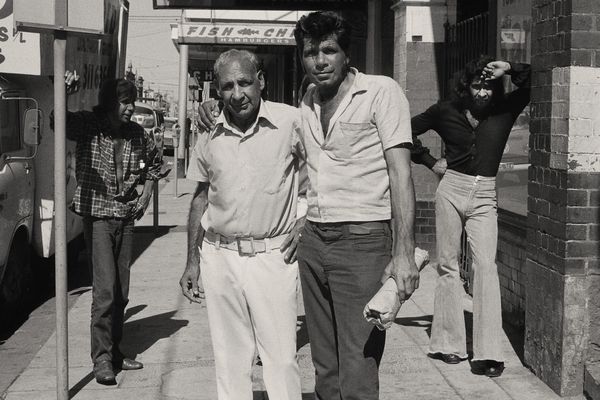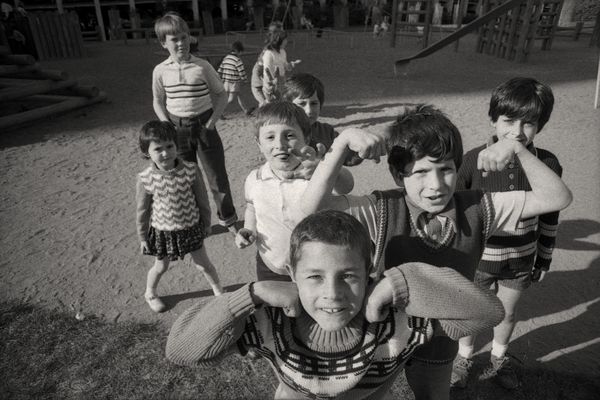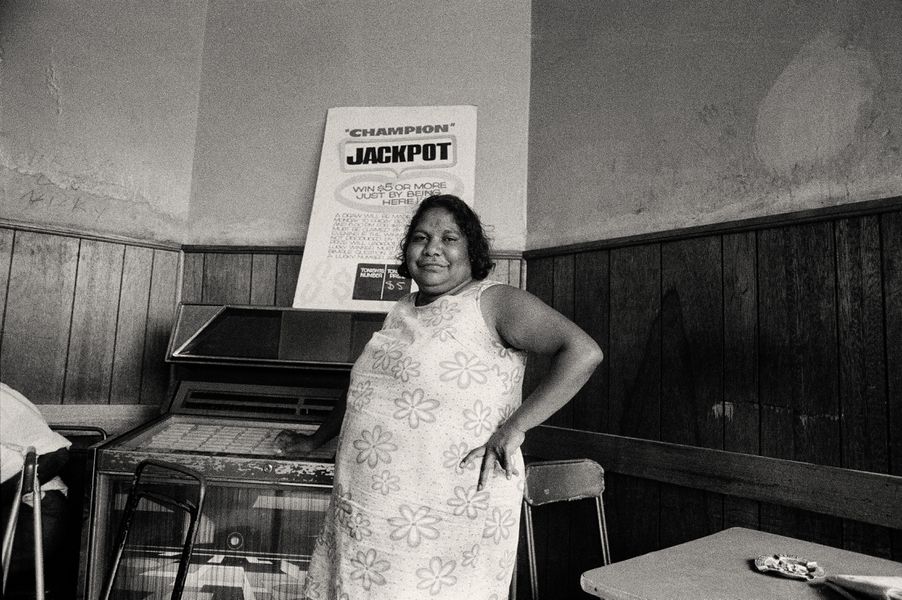Aboriginal and Torres Strait Islander peoples are advised that this blog contains the names and images of deceased people. Readings apologises for any distress this may cause.
Into the Hollow Mountains was originally published in 1974 and featured a collection of Robert Ashton’s photographs, accompanied by writing from various local creatives, including Helen Garner.
Fitzroy 1974 is a new edition of this iconic work with additional written contributions, edited by Gregory Day, which celebrate Ashton’s rare observational talents and reflect on an influential suburb captured during a time of historic change. This edited extract is from one such piece by Tony Birch.
Throughout the 20th century, the inner-Melbourne suburb of Fitzroy (on the land of the Wurundjeri nation) was often utilised as Australia’s social test-tube. Charity organisations, welfare workers, demographers, newshounds and evangelicals all trawled the streets of Fitzroy chasing tales of the supposed criminality and debauchery of the suburb. In addition to reams of paper dedicated to surveys, reports and risqué tales of slum life, the people of Fitzroy and the narrow terraces, cafes, hotels and factories they lived and worked in were endlessly photographed by crusaders arriving unannounced on the doorsteps of the poor, migrant and Aboriginal families.

Within this setting, in the early 1970s, a young artist would photograph the same people who had been vilified or shunned by those seeking either authority, entertainment or, on occasion, both. The artist’s images would capture the spirit and heart of a community in a way that no photographer before him had sought to do. Robert Ashton, who had graduated from Prahran College in 1971, began his photographic work in Fitzroy in 1973. The images would be exhibited the following year at Brummels Gallery under the title ‘Into the Hollow Mountains: A Portrait of Fitzroy’, with the publication Into the Hollow Mountains (Robert Ashton and Mark Gillespie, Outback Press) released in the same year.

Robert Ashton’s subjects were Aboriginal people, workers, families, the elderly and the occasional new migrants to the suburb – artists. The locations for his work were pubs, shops, cafes, the streets, bedrooms, workshops and down-but-not-out balcony terraces remaining only one step ahead of the renovator. Similar people had been photographed previously, ad nauseum, by social reformers and religious zealots, as had the streets and houses the same people called home. And yet Ashton’s photographs could not have been more different from the narratives of misery and social evil that preceded his work.

Into the Hollow Mountains introduces us to people of agency, who, if not completely trustful of the camera lens, do not turn away from it. We meet groups of men playing cards in cafes, barbers standing in doorways waiting on a next customer, women who had dragged kitchen chairs into the street to hold court, workers enjoying a lunchtime game of football, and worshippers who sing and pray and dance. To suggest that Robert Ashton captured the human condition of a community is to state the obvious. And yet the point needs to be stressed. Until his photographic project, except for family photograph albums that produce a similar visual story, the human decency of the people of Fitzroy had been stripped from them. Their dignity had been replaced by a fiction justifying at times callous and violent intervention into their lives, be it the forced removal of children from families, or the destruction of entire streets by a bulldozer.

The children of Fitzroy had previously been represented as either victims of a dangerous neighbourhood or as a threat themselves, particularly towards outsiders. In Ashton’s images the children come alive: cheeky kids showing off before the camera, playing on the street with a pet dog, or mucking about on the grounds of the Atherton Gardens housing estate. The images are revealing. Despite the relative economic difficulty faced by many children living in the suburb at the time, they are also vibrant and energetic kids, in a manner absent of sentimentality. Nor are they forlornly waiting around to be saved by outsiders.

The approach Ashton adopts in photographing people might best be described as ‘spontaneous portraiture’, although several images do contain people caught unaware, ‘in the moment’, such as an elderly woman walking home with her shopping, a girl playing with her doll beneath one of the Atherton Gardens towers, and a group of card players shot through the window of a Brunswick Street cafe. More generally, Ashton’s subjects pose for the camera, with humour, pensiveness, occasional defiance, melodrama and an acute sense of choreography.
In a photograph taken in a Fitzroy backyard, not only does each member of the family look confidently towards the lens, the greyhound in the centre of the image appears to be more than aware of the occasion. While male bravado is on display in several portraits, it is represented with a self-conscious sense of theatre. Whether it be in the proud display of a topless ‘muscle man’, an urban cowboy in the bar of a hotel or two young men of the Fitzroy Flats embracing, rather than figures of menace, we are introduced to men of character.

In 1973, when Robert Ashton was walking the streets of Fitzroy with his camera, the suburb was home to the largest urban Aboriginal community in Melbourne. It had been so for several decades. When stories involving the Fitzroy mob appeared in the press, which was acutely quite rare, Aboriginal people were portrayed in a negative light, with the racist term ‘half-caste’ most often attached to tales of woe. The notion that Aboriginal people living in the suburb were members of a viable and vibrant community was never countenanced.
Ashton’s lens reversed this negative image. Aboriginal people actively engage with the camera, with an obvious sense of pride. A party of drinkers gathered around a table in the Champion Hotel do not shy from the lens. Nor do four Aboriginal men standing outside the same pub. Likewise, five Aboriginal women turning to the camera, looking simultaneously amused, strong and, in the case of the woman placed in the centre of the image with an open hand resting on her chin, possibly bemused.
Although no single image can speak for photographs contained in Into the Hollow Mountains, one photograph comes close to encompassing the value of the collection as a whole. It is a photograph taken inside the Champion Hotel of a powerful Aboriginal woman, wearing a sleeveless floral dress. She has one hand resting on a jukebox, the other on her hip. The woman is smiling at the camera, but only slightly. She is a true ‘Fitzroy Girl’ and, although she doesn’t appear to be at all hostile, the woman’s respect for the camera demands effort and sincerity on the part of the photographer. Behind the woman, a sign informs us that the ‘Champion’ jackpot is available – ‘Win $5 or more just by being here!’ it announces. The combination of this woman’s strength and the good luck that awaits punters is illustrative of the only story we need to know. In 1973, you could become a winner in Fitzroy just by being there.

This is an edited extract from Fitzroy 1974 by Robert Ashton, published this month by Hardie Grant Books. ‘“Just by being here!”: Robert Ashton’s pictures of love’ is an essay by Tony Birch included in Fitzroy 1974, edited here for length. Find out more about the book here.


